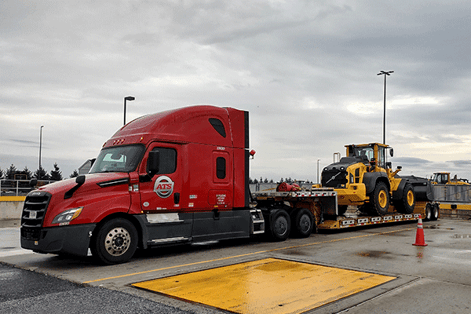
After nearly seven decades in the transportation business, ATS’ priorities haven’t changed. Our goal is to deliver for our customers so that they can deliver for theirs.
Sometimes, though, the things shippers need most are information and advice.
In the midst of an unprecedented pandemic that has made life difficult for people all over the world, the transportation industry has met each challenge valiantly. As we move toward 2022, and the challenges facing this industry continue to multiply, we expect the same results to follow suit.
ATS has been around since 1955 and we’re not going anywhere.
That said, we understand why some recent developments in the world’s battle against Coronavirus would leave you with some questions about what to expect going forward.
Although it’s too soon to definitively predict the impact things like a vaccination mandate will make on the transportation world long-term, this article will serve to help you navigate this most recent development.
Below, you’ll find:
- An overview of the cross-border and Canadian domestic vaccination mandates.
- How vaccination mandates could impact the transportation industry.
- Three things you can start doing now to prepare should things see a significant shift going forward.
What We Know About The Cross-Border Vaccination Mandate
Throughout the waning months of 2021, American and Canadian lawmakers have taken aggressive strides aimed at stalling the spread of Coronavirus within their borders.
Doing so, however, has taken firm analysis and a variety of mandates.
Today, all international travelers seeking entrance into the United States and Canada via air need to provide proof of their full vaccination against COVID-19.
Although these vaccination mandates — which apply to all non-citizens regardless of their reason for traveling — initially only regulated air travel, in January their reach will be extended to border crossings via land as well.
Estimated to be fully enforced by the end of January 2022, cross-border mandates will require all foreign nationals traveling into or out of the United States or Canada through their shared border to be fully vaccinated — either with Moderna/Pfizer’s two shots, or Johnson and Johnson’s one.
Despite pushback from shippers and transportation companies alike, it has also been confirmed that the rule of these cross-border mandates will apply to commercial truck drivers.
The Canada and U.S. mandates — which are set to take effect on January 15 and 22, respectively — mark the latest attempt by officials to deter the continued spread of Coronavirus across the border.
That said, with so many shipments crossing the U.S.-Canada boundary each day, many industry experts are worried about the impact this will have on a pair of national supply chains that are struggling to keep up as it is.
What We Know About The Canadian Domestic Vaccination Mandate

Beyond simply a cross-border vaccination mandate, Canadian officials have recently taken steps to transition these regulations into encompassing all federally-regulated workplaces beginning in early 2022.
This expanded mandate is likely to include Canadian industries such as trucking.
This domestic mandate comes despite significant pushback from the Canadian Trucking Alliance, and the Private Motor Truck Council of Canada, which warn that these mandates could significantly impact Canada’s trucking marketplace by reducing its supply of drivers.
Conservative estimates from industry experts attest that — without amendment — a widespread vaccination mandate could see as many as 30,000 drivers exit the Canadian market entirely.
How Will These Vaccination Mandates Impact North American Supply Chains?
For decades now, the United States and Canadian economies, have been interconnected in many respects.
According to a report compiled by the Office of the United States Trade Representative, 718.4 billion dollars of goods and services were exchanged between the U.S. and Canada in 2019 alone. This number supplanted Canada as the second-largest trade partner, and largest export market, of the United States in this year.
But 2019 wasn’t an anomaly.
In fact, the total amount of goods and services exchanged between these two countries has increased substantially throughout the 2000’s decades and looks to do so well into the future.
In relation to trucking, it’s estimated that nearly 70 percent of the total goods passed between the United States and Canada are carried by trucking companies and their drivers.
That said, recent history has not made it easy for trucking companies to shoulder this burden.

According to the Canadian Trucking Alliance (CTA) — a federation of thousands of trucking associations across Canada — the Canadian trucking market is already short on drivers, with more than 18,000 vacant positions as of November 2021.
Starting at the onset of 2020, the United States began feeling this same burden with the market falling an estimated 80,000 truck drivers short of where it needs to be.
These shortages — which can be attributed to things like the widespread shutdown of driver training schools and rehabilitation facilities — have taken a toll on the freight rates shippers pay for capacity in demand-saturated marketplaces.
The vaccination mandates on cross-border travel will likely make this even more challenging.
In 2021, the massive demand for freight transportation across the United States’ northern border was shouldered primarily by Canadian truck drivers, with the CTA sighting totals of 120,000 Canadian cross-border drivers to the United States’ 40,000.
Although a widespread vaccination mandate targeting all federally-mandated Canadian workers – truck drivers included — is set to publish in early 2022, leaving Canadian truckers with little choice, a reduction in cross-border capacity is likely.
Unvaccinated American drivers, looking to avoid this mandate will be forced to re-position their services away from cross-border shippers, stunting this supply.
And, even if 90 percent of the current pool of United States-based cross-border drivers are vaccinated, a 10 percent swing in capacity has the potential to make a massive impact on international supply chains.
The finite number of transportation solutions on the market today will only dwindle as these mandates take effect.
In turn, the carriers that serviced these lanes in the past may be forced to become more selective about which customers they services as their pool of qualified truckers falls.
How Should You Plan For The Impact of These Mandates?
If you have effective processes in place and a good mix of providers in your corner, your planning shouldn’t really change. That said, these mandates won’t make it easier to find your freight a viable cross-border solution.
With this in mind, here are three ways for you to navigate this ever-changing transportation landscape:
- Communicate with providers.
- Prioritize lead time and flexibility.
- Make your freight as appealing as possible.
1. Communicate With Transportation Providers
The transportation industry is no stranger to adversity. Making it in this industry — particularly over the long term — takes adaptation, expertise and a commitment to top-of-the-line service quality.
Great transportation providers know this. These are the companies you’ll want to work with — especially during trying times. Make sure to fill your network with them and touch base with each provider before these mandates take effect.
Ask your provider how your business will be impacted by this latest change. Touch base with these carriers on how their capabilities will change in January and what you can do to ensure capacities going forward.
Without planning properly, transportation companies won’t have the tools in place to provide the services their customers need and deserve. If one of your frequently-used carriers doesn’t have a plan in place or answers about how your supply chain will be impacted, it might be best to look elsewhere.
2. Prioritize Lead Time and Flexibility
When mid-January comes around and these vaccination rules are adopted, the impact of lead time and flexibility on your ability to secure capacity will only rise.
With fewer qualified truckers to utilize, asset carriers and freight brokerages alike will need additional leeway in finding your solution. As such, wherever possible, be sure to give your transportation provider no less than 24 to 72 hours of notice prior to the moment your freight needs to load.
This amount of warning will help your partner find your best-fit solution at competitive price points.
Beyond this, where flexibility is concerned, offering wider windows of time for loading/drop-off appointments will be another great tool. In tight markets, rigidity makes it all the more difficult for businesses to secure capacity and, in many instances, drives rates skyward.
For this reason, offer your provider a window of 8 a.m. to 1 p.m. (for example) for a pickup rather than holding to a strict 9 a.m. appointment. Doing so will give them more options to match your freight with — saving you money in the long run.
3. Make Your Freight More Appealing to Truckers
In a transportation market where the demand for truck space outweighs supply, forcing carriers to prioritize the loads they accept, appealing to trucking companies and their drivers can be really impactful.
Although there is a long list of things you can do to attract more drivers to your business, here are some of the most common tactics:
1. Offer overnight parking for drivers to utilize2. Offer truck driver amenities like:
-
- Showers
- Cafeterias
- Bathrooms
- Designated dog-walking areas
- Staging freight
- Hiring part-time help
- Standardizing procedures
-
- Don’t max out the trailer (which is hard on their equipment and fuel reserves). Instead, offer lighter-weight FTL quantities.
-
- Help drivers throw tarps, consolidate multi-stop freight, etc.
Doing these and things like these will help your business become a landing spot for drivers as they look to make the most of their limited hours of service.
Don’t Worry, You’ve Got This!
Look, the trucking industry is comfortable with uncertainty. Over the decades, plenty of things have made it difficult for trucking companies and their drivers to meet demands. And, time after time, the best companies have adapted to these changes and kept supply chains moving.
So don’t panic.
Although these vaccination mandates are another bump in what has been an interesting last couple of years, with a steady hand, they’re navigable.
That said, as our nation continues to battle COVID-19 and the world around us does the same, it’s important that you prioritize your wellness.
Go outside, read a good book and spend time with family. With so much going on, it’s easy to get caught up in the stress that life brings.
Should you have questions about how this latest Coronavirus mandate will impact your business or industry, reach out to us here at ATS.
We’ve been around long enough to know how to things like this impact the trucking world. Thinking out-of-the box, and planning ahead are great ways to maneuver uncertainty in the transportation world. We’re more than happy to show you how.





